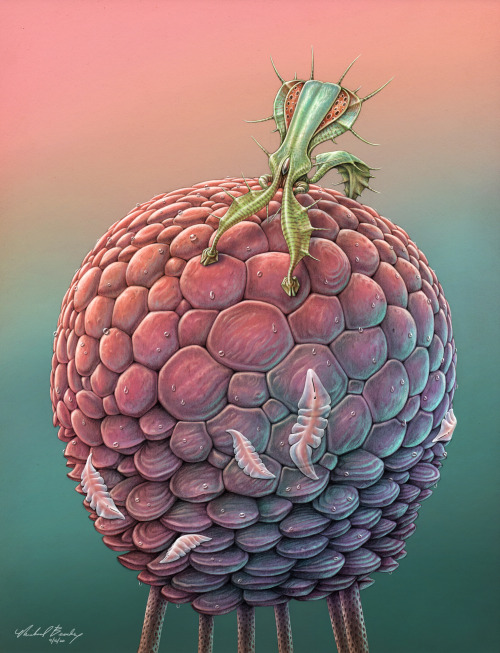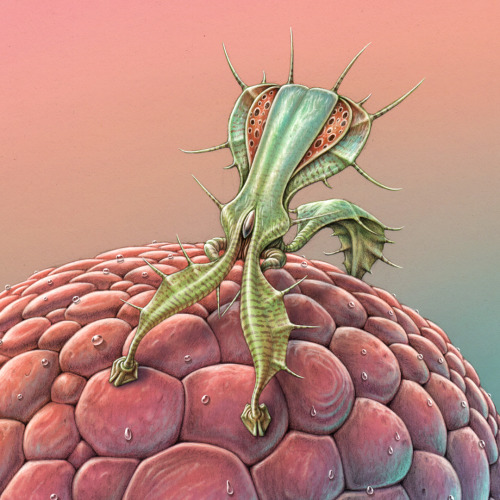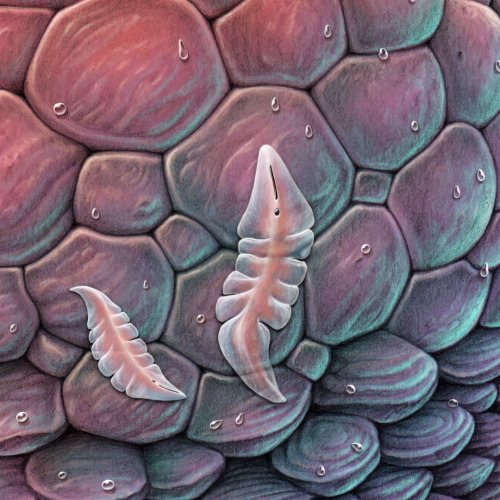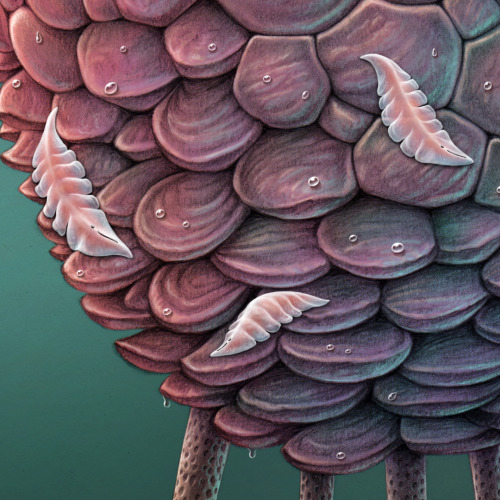exobiotica
exobiotica.com A journey to other worlds.
61 posts
Latest Posts by exobiotica






Life on the Seafloor
Some habitats are very consistent from planet to planet across the universe. The bottoms of deep oceans generally experience similar conditions—extremely high water pressure, zero sunlight, and a constant rain of organic debris known as marine snow. Thus, organisms on the deep sea floor of Veteris developed common traits in parallel to their counterparts on Earth. The darkness eliminates the need for most pigments, so most creatures are rather drab. In order to grab bits of food from the water column, many utilize grasping appendages covered in sticky setae. For every scrap of nourishment that can be found here, there is a creature that has evolved to exploit it. Far from being a desolate wasteland, this seemingly inhospitable environment is full of bizarre, perfectly-adapted inhabitants.




The climate in this region is usually hot and dry, punctuated by sporadic torrential downpours. After such events, the ground flourishes with a dense interconnected web of growth taking advantage of the temporary hydration. Once all the water dissipates, the soil is left to crack in the heat of the day. During these times Ponderosus are on the move, searching for the last remaining vernal pools. They used the times of plenty to fill up on nutrients, but now during a drought they switch primarily to photosynthesis to meet their energy needs. The smaller, dish-faced Lanx are not so lucky. Embedded in the ground unable to move, they must simply go dormant if the rains do not arrive soon enough. For now they point their open frills at the sun and gather energy while they still can. A Stealthspring prowls the scene looking for unfortunate small creatures who may not be faring well in the heat. Their predominant walking style requires a different gait for front and back sets of legs, but if needed their whole body becomes a giant spring, allowing them to burst forward for great distances. In an environment where major features like the ponderosus can move, it can be difficult to navigate from day to day, so the stealthspring must be ready to take flight at any time, should danger come calling.

A common site in these dry rocky areas is the Velumignus. Their immobile bases send tendrils deep underground in search of water, while the photosynthetic flattened upper portions can swivel to accommodate for light and wind direction. Reaching a height of over fifteen feet, these silent sun-catchers often serve as way-finding posts to creatures journeying through the High Desert.




In my orange phase.






As Above, So Below
Throughout most of the year, the nighttime skies of planet Veteris are illuminated by a vast, brilliant nebula. Tiny photosynthetic organisms multiply during the daylight hours, and after sunset the surface waters become a thick soup of predators ascending from the deep to feed on them. Any creature seen from below will be silhouetted against the glow of the sky above. To prevent becoming easy targets for predation, many blend in by producing their own light. In their swarming multitudes, these billions of incandescent swimmers create biological nebulae beneath the waves. Massive filter feeders like the ghostly white Niveus have no need for such camouflage. Their immense size and surprising speed are enough to keep them safe as they cruise these starry seas.



More strange megafauna.






In the waters of a lowland swamp, a dramatic scene unfolds in miniature. The skeletal remains of a long-deceased creature have been colonized by a gelatinous, rather fluffy organism known as Rugosa. Covering any available real estate like a crumpled, spreading blanket, this filter feeder removes organic particulates from the surrounding water. Swamps with high levels of Rugosa growth maintain a more transparent water column, hosting more autotrophs and greater biodiversity. Firmly attached to this ensconced matrix is the decaying husk of a once mobile Flame Diversoma. Its last dying act was to serve as a shelter for its numerous offspring, which are now developed enough to disperse en masse. The coordinated timing of this exodus is critical, for a slow diffusion of these larvae would make them easy prey for the surrounding cadre of predators, who have gathered in anticipation of this event. The most successful hunter thus far is the Spotted Spearmouth, which relies on its harpoon-like proboscis to stab the passing swimmers and drag them into its maw. A vast swarm of semi-transparent Swamp Pearls paddles along slowly, unaware of the violence unfolding nearby. Having little in the way of visual sensors or situational awareness, their lives are consumed by chasing the flow of nutrients and favorable conditions in this tangled aquatic realm.





A Giant Forest Walker




In the Shadow of Colossus
Veteris is a geologically dynamic world, with active plate tectonics that thrust huge mountains high into the sky. One of the highest ranges is Colossus, which contains peaks well over 50,000 feet tall. Here on its outskirts, deep valleys have formed, whose unfortunate position robs them of sunlight for most of the daytime.
These twilight conditions are not favorable for creatures with high photosynthetic needs, but provide opportunities for others. The ominous Valley Plate-globes are covered in dark panels that absorb as much sunlight as possible during the short daylight hours. Rising far above the ground are the Skycolumns, who extend their fleshy fronds when the sun is directly overhead. Their main body column is heavily buttressed to prevent being toppled by strong winds.
The particular species of tube carpet that covers the valley floor grows a large glowing bulb which carries a multitude of its microscopic embryos. Once the bulb reaches a certain size and luminosity, it attracts the attention of mobile creatures, who by eating it spread the tube carpet’s offspring far and wide. The primary patron at this bioluminescent buffet is the Ghost Celeriarma, a swift and well-defended denizen of the shadow lands. Like many inhabitants of Veteris, it utilizes a combination internal/external support structure that is both flexible and strong. A turret of eyes extends high above the rest of its body and gives it 360 degree surveillance capability. If eyesight should fail to detect a predator, its quick speed and sharp, moveable spines may keep it safe.
A far less athletic creature, the smaller Pluriped has instead developed camouflage to avoid predation. Lateral markings and a glowing bulbous growth of its own help it blend in to the shadowy sea of tube carpet.
You are one of my biggest inspirations for creature design. Your aliens are beautiful and unique, and when I look at your art it feels like I’m actually there! Your art is beautiful
Thank you so much! I’m honored to be an inspiration for you.




Creatures of the Open Ocean
A few species profiles out of the many inhabitants of the oceans of Veteris.

Brand new website!
Check out Exobiotica.com for all your weird alien needs. Get prints, read new content, and go in-depth into the project. Enjoy!






Interwoven
Like a giant pink warship, the Rosy Frigate punctuates the endless sea of tendrils. It hosts a crew of disk-shaped ravenous eating-machines called orbics. It is the orbics’ duty to keep the creeping tendrils from strangling and overtaking their home. Fading daylight signals their departure from the safe cluster beneath their giant companion to begin the night’s work of clearing new growth in the near vicinity. Each orbic can consume half its body weight in tube-carpet flesh every night, ensuring they will always have a place to return to at dawn. A Dwarf Blue Cortina observes the melee in confusion. Anything larger than an orbic will send it leaping away for cover, as its curiosity is matched only by its caution. The stoic quartet of Reponos standing solemnly in the background is incapable of seeing or hearing the events taking place nearby. Their role in this ecosystem turns out to be rather bizarre…






First Light
Dawn breaks in the desert, revealing a scurrying frenzy of creatures returning to shelter after the night’s mischief. Tallest among them, the Cycloptic Night-Seeker surveys the scene looking for any last morsel of food before the day’s solar onslaught forces its retreat into shadow. The Testapallidus at its feet may prove an ideal treat, unless the sand-swimming Armored Loricatus captures it first. Though the Testapallidus’ hard dorsal shell protects it from most threats, the Night-Seeker possesses a keen intellect, curious disposition, and two formidable front appendages that are as dextrous as they are sharp. Usually too quick for the large hunter, a trio of gregarious Desert Sentinels are more concerned with ambush predators such as the Loricatus, and one inflates its signaling air sacs in alarm. Already, members of the desert’s daytime cast are making an appearance. Luteos have positioned themselves at the top of the ridge to greet the first slanted rays. Relying on photosynthesis for a large portion of their metabolism, they tilt their bodies to follow the sun throughout the day. In a short time, more heat-tolerant daylight denizens will take the stage and play out their part in the everyday drama of the high desert.
I like your art. It is such a beautiful place and I can see Veteris being a wonderful place to explore in your art and world.
Thank you! I have a world full of ideas to bring to life, it just takes a long time.
I saw you're a graphic designer.
Are you commissionable for creature designs or similar projects?
If not that's OK. Like your art
I’m not currently available for commissions, sorry. I definitely will keep making art though. Glad you like it!
are all these illustrations from the same book or something?? If so I literally need to buy it they’re so cool
It’s all my art- as soon as I’m done with a piece, I post it here. Eventually I want to put them all into a book, but that’s years away. I’m glad you like them, there’s much more on the way.




Kings of the High Desert
A herd of strange creatures has congregated on this rocky outcrop. Known as Emperor Shinebacks, they often climb these rugged foothills to obtain access to cooling breezes and additional food sources. Their top-heavy tripodal stature prevents further ascension into the mountains, but it serves them well on more level ground. Reflective carapaces mitigate much of the sun’s harmful rays, and cooling flaps along their flanks dissipate excess heat. A shineback’s normal gait is rather clumsy, but when haste is needed they clamp all three legs together into a single monopod and bounce effortlessly across the desert at remarkably high speeds. This combined with their massive size (adults are over eight feet tall) and protective social behavior makes them almost impervious to attack. Almost…






The Garden of Unearthly Delights
Biodiversity in Glow Forest Communities
Down on the floor of the Glow Forest, a startling array of lifeforms has evolved in the cool dark mist. The creatures that comprise the main structure of this biome are known as Vela, and they stretch skyward, consuming all the available sunlight and allowing none to escape below. This species won an evolutionary arms race long ago, and as a result its photosynthetic competitors were pushed to extinction. However being a successful monoculture has its disadvantages. Autotrophs form the base of the food chain in most environments, and now the Vela is the only one. This means it is now the main food source for many other species who would otherwise have more choices. Its main nemesis is the Stragulum. This amorphous creeping wrinkled blanket infects a new Vela pseudopod nearly as soon as it touches the ground. It rapidly takes hold and covers every inch of the surface, slowly digesting it. This in turn attracts a cadre of new organisms which consume the flesh of the Stragulum. Predators are then drawn to the area, and as the number of species grows, a self-perpetuating cycle of increasing biodiversity takes place. Eventually, the Stragulum becomes too much of a burden to the Vela and it severs its pseudopod in order to rapidly grow another nearby. But the biomass of the parasite still lingers for quite some time, feeding a plethora of bizarre and unique organisms scrambling for their share of the resources in this oasis of light amidst the darkness.






Codependence
Natural selection breeds competition, but it can also lead to sophisticated cooperation. The Glass Colligatio is what is known as a composite organism—a creature comprised of members of multiple species that share critical biological processes between them. The larger swimmer provides mobility, while its multi-legged symbiont feeds more efficiently than it could alone. Through the interspecies junction—a specialized dual orifice connecting the creatures—they share nutrients and oxygen, each specializing in what it does best while providing for the needs of the whole.






World Eater
In the murky ponds on the floor of the Glow Forest lives a surprisingly diverse community adapted to the near total darkness. Decaying organic material releases methane gas which is harnessed by towers of colonial microorganisms. Upon this bedrock of the food chain, a plethora of creatures creep and crawl about their daily lives while trying to avoid the pond’s top predator - a massive leviathan blindly devouring everything in its path.






A Universe Below
Almost no sunlight penetrates the thick canopy of the glow forest. As a result, organisms in this ancient biome have evolved a massive array of survival strategies using bioluminescence. Some emit light to attract mates or warn against predators. And some, strangely, illuminate themselves in order to be eaten.





Full of Stars
The season's storms had taken their toll, opening up an organic cave in the otherwise sealed mountain canopy forest. Encouraged by the prospect of shelter from more incoming inclement weather, the dacia considers entering the dark, yet inviting refuge. The glittering biolights beckon, but this new environment is far stranger than anything it’s ever known.



Life in the Low Forest
A relatively dry and sunny climate favors some types of forest over others. The tangled matrix of the fast-growing tube carpet forms the floor along the majority of this habitat. It grows so quickly that other species of photosynthetic creatures find it advantageous to be more mobile, lest they be crowded out and overtaken. The scarcity of water combined with the tendency towards mobility versus upward growth means this forest is relatively short in height - hence its name. There is a rich and varied food web here, with many organisms feeding on the tube carpet, keeping its ravenous growth in check. It also offers a complex labyrinth in which to hide from the many predators working tirelessly for their next meal.





Herders
Out on the plains, a group of herders watches over its flock. At around 15 feet in height, the Magnavindix have flat tops, good for catching the sun’s rays to supplement their energy requirements through photosynthesis. The majority of their sustenance however, comes from the placid, defenseless Iumentus creatures they tend to. Imposing in stature and well armed, they play the role of defender, shepherd, and also matchmaker, bringing a pair of Iumentus together when their biolights signal readiness to breed. Indeed this symbiosis has grown so exclusive that the Magnavindix have evolved specialized appendages that are only useful in carrying the Iumentus. Having no concern for danger, the livestock are free to grow fat and slow as they wander the open plain, grazing on the expanse of the fibrous purple carpet creature that dominates this land. Other species benefit from this arrangement too. The shy Brush-faced Verecundas stay close to the herd as their giant guardians deter nearly all predators that would attempt to approach.





Life in the Dark
In the murky blackness of the deep sea, creatures are spread out over immense distances. To find each other, many use biologically-generated light. But what appears to be a potential mate might instead be a lurking predator.



Pelagic predator pen sketch. More on this soon.





Forest Floor
The long tendrils of the Purple Spire Creeper encircle this forest community deep in the valley. Following its traditional hunting path by the river, the predatory Veloxos has spotted its prey – a Dish-Faced Septaped that emerged from the undergrowth for a drink. The Septaped’s teal, reflective surface camouflages it well in its dimly-lit damp home on the forest floor, but now out in the open it appears as a shining beacon. After this brief instant of mutual acknowledgment, the race begins. The Veloxos’ three powerful hydraulic legs can propel it with surprising swiftness to get it within striking range of its harpoon-like proboscis, which extends almost instantaneously to the full length of its body. The Septaped is a formidable quarry. Though it possesses no defensive mechanisms, the seven muscular legs aligning its body can nearly teleport it back to its shady lair - where it will become lost in the shadows. The perpetual arms-race of natural selection continues daily all across the planet with countless moments such as this.




Guardian
On Veteris, it is common for creatures to obtain energy from multiple sources. The large round, multifaceted autotroph angles its plates to face the light at any given time of day. It also feeds on decomposing organic matter it obtains by moving slowly on its long spindly legs. Conversely, the spiny guardian on top originally evolved to hunt the semi-transparent flat creatures that feed on the autotroph, but came to rely on them exclusively. Over many generations, individuals that allowed some prey items to live and reproduce eventually outlasted the more aggressive hunters, and now their style of subsistence is closer to farming. The guardians now protect the entire micro-system – each large round walker and its flock of parasites is topped by a spiny guardian who has the dual task of defending against predators as well as keeping the herd numbers in check. A round walker without a guardian slowly succumbs to parasite overpopulation. Occasionally huge numbers of walkers congregate in vast gently-swaying miniature forests, each crowned by a flamboyant spiny guardian defending its small world.



